Does Your Team Feel Unseen? Close the Leadership Disconnect with 2-Way Communication
Editor's Note: In July 2025, EMS1 and Fitch & Associates released their annual EMS trend survey, What Paramedics Want, proudly sponsored by Pulsara....
11 min read
 Team Pulsara
:
Jun 16, 2021
Team Pulsara
:
Jun 16, 2021
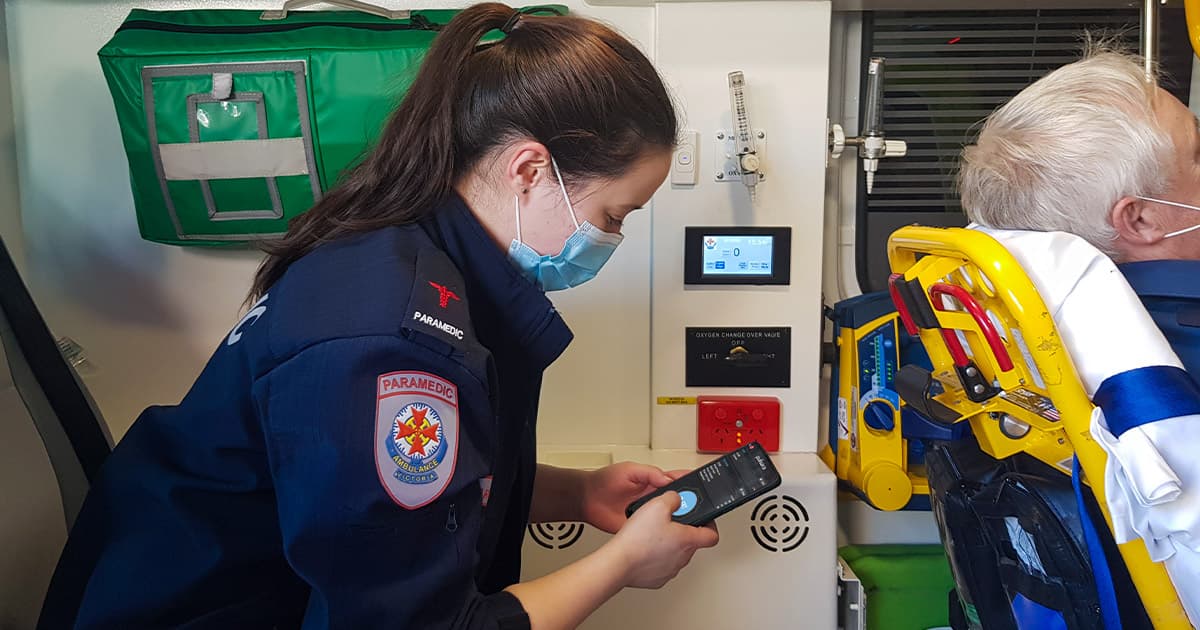
New technology is often an exciting prospect. It's fun to experiment with, especially when it promises to help streamline a cumbersome process. But ultimately, the true test of technology is whether it actually improves the way you do things...and when it comes to technology in healthcare, how it helps you provide better care for your patients.
So when a group of leading experts and clinicians in Victoria, Australia implemented Pulsara to improve communication between their care teams, they were curious about what the innovative new technology could do for them. But more importantly, they wanted to see what it could do for their patients.
Over the past few years, they have successfully developed a streamlined system for making sure everyone on the team has the right information at the right time. And, they're happy to report, their new system has helped them provide stellar care for their patients.
In the final entry in this three-part series, you'll hear directly from the team on how easy it was to implement Pulsara, the results they've seen from it, and how they've united all their care teams into a regional system of care.
View the full webinar video discussion below, or read on for Part 3 of the full roundtable! (Check out Part 1 and Part 2 here.)

Kris Kaull:
Based on the data, what would you describe as your number one win that you'd like to share with others? What are you most proud of?
Grant Hocking:
The number one is just best care—patients' best care. I mentioned some of the data earlier, but we can see now that we're doing much better for our patients. So overall, whether it's a stroke patient, a STEMI patient, a trauma patient, a mental health patient—no matter what, it's actually improved and, as I said, streamlined their care and made improvements across the board. So, best care for patients.
Chris Bladin:
The number one win for me is that we actually made it happen. And I have to say, when we first started doing this and I was working closely with Katie on this implementation, the more I went down this rabbit hole, the more I realized that this was a big task and there were so many different players. And people were bringing so many different perspectives to the table. As Katie highlighted, I tend to be an early adopter. And I had perhaps mistakenly assumed everyone would think this was a great idea, and let's run with it. But it was good to reflect on the fact that the adoption curve has got a lot of ups and downs in it, and while I may perhaps be at the front end, there are people who are down the back end. And at the end of the day, you've got to bring everyone along. So it was important that we have everyone in the room, that we get them talking together, and that we really instill in everyone that there's a common purpose here, and it is all about doing what's best for the patient. And, "Yes, I know that you've used the phone for over a hundred years, and that's how you've always done communication, but you're making three or four phone calls to achieve what could be done with one or zero phone calls because the information is instantly available to you."
"It was important that we have everyone in the room, that we get them talking together,and that we really instill in everyone that there's a common purpose here,and it is all about doing what's best for the patient."
So bringing people along I think is really important, and as has already been highlighted here today, having people on the ground who were project managers to really get this up and running was a very key step. Because every so often, someone just wants to drift outside the tent. You've got to pull them back in, get them back on the same page, and make sure that they understand their role in all this and get the whole thing running efficiently.
Kris Kaull:
Chris, when you were talking about that, it reminded me of when Katie said, we're now communicating how we should be communicating present-day. Katie, maybe you can speak to the fact that when you worked in the hospital, while you were clinical from the data side, you weren't necessarily clinical from the practice side. And so when you sat at the table and heard how you were communicating, I think the word was, "I was horrified," to see, wait, this is how we communicate during a situation when time matters? What would you describe as your number one win?
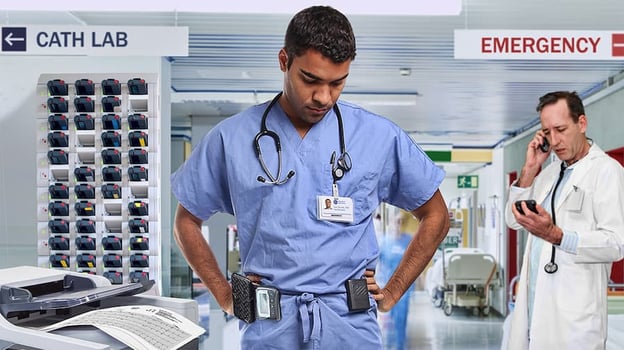
Kathleen Bagot:
Oh, that's true. I would come out of meetings and I would ring Chris and I'd go, "Is this true? This is what they're telling me. Is this true?" Yeah. I mean, we were implementing paperless faxing in 1991. So to be going into a hospital and then being shown a fax machine in the ED area and hearing, "Yeah, sometimes those ECGs drop down there, and then we have to move the...." My mind was blown. So the number one win, I agree with what Chris and Grant were saying about patient care. It's amazing that we did it. We did do it. It was great. And we had a lot of help and there was a lot of great goodwill from everyone in the hospital when they saw what it could do. There's a lot of truly interdisciplinary patient-centered care. We put a patient-centered communication system into a patient-centered care model of healthcare delivery. And that's what the Pulsara app does. It takes you right from the start of the patient journey at the bedside in the person's house, all the way through the treatment being delivered. It's one system, and everyone who needs to see what's going on can see what's going on.
"We put a patient-centered communication system intoa patient-centered care model of healthcare delivery."
You can see all of the important bits of information. You can ask for information that might be missing just by typing something in, and someone will respond. And then at the end—which is where the data researcher gets super excited—all of that data is in one system. We had to go to five different systems to work out what was happening pre-Pulsara for stroke. We had to go to five different systems in the hospital and Ambulance Victoria to find out what was happening for cardiac events. And with Pulsara, it's all in there in one system that you can download out into Excel. So putting in a patient-centered communication system in order to support a patient-centered care model was my number one win.
Kris Kaull:
I love that. As a clinician of nearly 30 years—so I'm right there with Grant and Janet—technology that helps clinicians focus on what they do best, which is take care of patients...you just don't see that, right? And you guys are focusing on the outcomes, you're focusing on morale, and you're focusing on communication, but what you're really doing is focusing on the patient.
There are two things you guys said throughout today that I want to reiterate and then ask Janet about. One, you said that everything is streamlined. And then two, you guys shared that everything is transparent and everybody can see where everybody else is and what they're doing so that there aren't any miscommunications. Do you want to speak a bit to that, Janet?
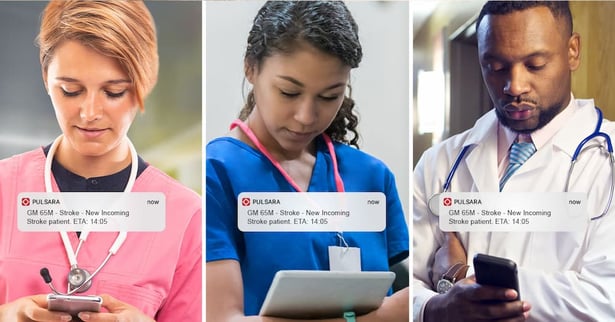
Janet May:
Yeah. Well, as I said before, I think we've really eliminated a lot of our patient demographic data coming in because internal teams can see exactly what's coming in. It's really helped speed up the whole process. So when you asked about what we're most proud of, at the end of the day, it's quicker treatment times for the patient. You don't have to spend time doing multiple phone calls. [And we used to have to send a page to all the doctors, too.] So that's all been cut out now. We've had a 68% improvement on our door-to-CT times, just for our stroke patients. And that always has a flow-on effect, because we've cut out all that doubling up of data. We have an iPad as well that sees the Pulsara information. So when the details come in from the ambulance, they put the medical record number and confirm all those details. So that's all done before the patient comes in. It's certainly cut out a lot of time.
Kris Kaull:
That's great. I think we're going to finish with some questions from the audience. And Katie actually if you'll take this one, the question is, how complex is the Pulsara system? Is it easy to set up or adopt, or is there a big learning curve?
Kathleen Bagot:
That's a great question. There are two elements to it. One is getting it into the hospital or the ambulance side, and then at the individual level. And, it was easy. You had to have your hardware, like your mobile phone, or your iPad, like Janet mentioned. The app is now on the ambulance truck phone that's already there. And then there are specific devices in the hospital setting. There's a backend that people in the hospital can then control so that they can add users and move users around. The Pulsara team came out from the states for a few days and they helped set all of that up. They worked with all of the people from the IT group all the way through to the clinicians. We worked closely with them. We had the project managers involved at the hospitals, which were local people, local clinicians, part-time.
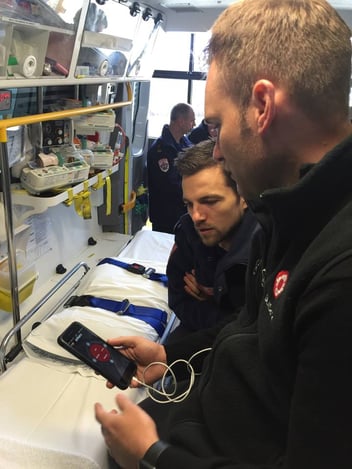
And then the learning curve. I had a paramedic who said, "No, this is not for me. I'm old school. I'm just going to get the young guns on the truck—they'll use the app."
And I said, "Look, come on. Here's a chocolate Freddo Frog. If you use this...." (I went through hundreds and hundreds of Freddo Frogs.) But I said, "If you can text and if you can take a photo on your phone, you can use Pulsara."
So he was very dubious. I got him to do the demo on the ambulance phone. And then within an hour—no word of a lie, within an hour—he was out in the community, and they had a patient with a suspected stroke. He used the app as the ambulance was in the bay and they were pushing the patient through and he's yelling out to me, "Katie, I did it! I did it. I've used it. We did Pulsara." And I'm thinking, "just get that patient into ED!" So it was really easy.
Kris Kaull:
That's fantastic. I love that. Janet, another question says, "We are already using multiple communication and telehealth systems. Is Pulsara redundant?"
Janet May:
No, definitely not. It's not redundant. I think it complements the systems that you already have. It enhances your workflow that you've already got. And it actually cuts out the paging and the multiple other processes that you have, as well. So I think it just helps streamline and enhance the processes of communication strategies that you're already using, really.
It complements the systems that you already have.It enhances your workflow that you've already got.
Just to add a bit to the last question as well, we found the system quite easy to set up from more of an end-user point of view. We had an online training session, and I think it was only like 15 to 20 minutes for the end-user to work out how to use Pulsara. And to be honest, you don't even really need to do it because you can teach yourself. Though it's good to do because you can see the extra features. I think it's very user-friendly, and we found it quite easy to implement.
Kris Kaull:
Perfect. And let's see, we really only have time for maybe two more questions. Grant, how does this model work across your hospital region? You talked about urban areas and then very rural areas. Can Pulsara be used effectively across an entire area health network in both rural and urban contexts?
Grant Hocking:
Thanks, Kris. Yeah, that's possible. In my region, in the Grampians region, it's only at Ballarat hospital. But Ballarat, being the largest hospital in our region, takes in patients from a large area, up to hundreds and hundreds of kilometers away. So when we introduced it, and it's still the case today, we had it in our Area One, which used to be called Central Grampians. That goes as far as Ararat and Avoca up to Daylesford. So, people that know the area, there's upwards of a couple of hundred Ks between those communities. And it works fantastically well, because again there's a lot more lead up time for the hospital to get stuff done, and a lot more communication happening between the crews and the hospital staff, medical, or admin, or whoever. And as Katie said, it was simple to use.
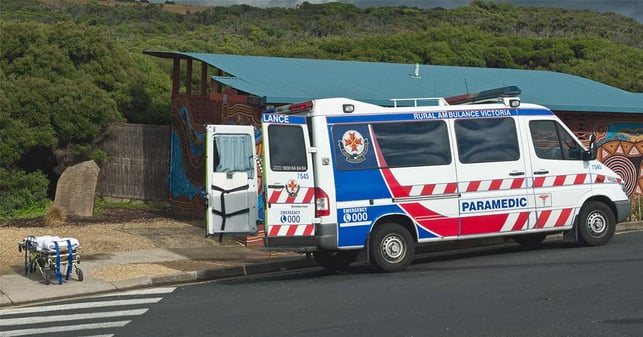
But what we found as an additional bonus was a lot of our paramedics, apart from just having it on the ambulance vehicle phones, actually have the app on their personal devices that they carry with them every day and night. And outside of the boundaries of that central Grampians region, I had crews that would less frequently come into Ballarat, but they wanted it as well. And at the time, we could only put it on their personal phones. So there's a couple of dozen at those scattered-around, smaller branches that have it on their personal phones and use it from time to time when they do come to Ballarat. So it can work across a broad area and even outside our target area that we had initially planned for. It's got scope to go a lot further and into metropolitan areas, as well. If we've seen the results we've seen in a couple of hospitals, Ballarat and Bendigo, it would be transferable that we would see it in the larger metropolitan hospitals as well.
Kris Kaull:
I finally have one final question, and this is for you, Chris. It says, "What's the return on investment with Pulsara? And what is my next step if I'm interested in pursuing Pulsara?"
Chris Bladin:
Great question. When it comes to return on investment, it's important to look at the context, right? So there's a couple of elements. Firstly, I find that when we talk about these digital tools, usually, the more simple and easy to use they are on the surface belies the complexity and depth of R&D that goes in under the hood to actually produce that simplicity. A good example is my iPhone, right? A four-year-old can pick it up and work it, but that's decades of work that have gone into this to make it work and appear as seamless as it is. So it is very simple to use. That's the first thing.
The more simple and easy [a tool is] to use on the surface usually belies the complexityand depth of R&D that goes in under the hood to actually produce that simplicity.
The other element is the context. We have found that, because of the value in this communication and the resulting improvement in patient care, you have to look at what the alternative would be. And the alternative is the old days, where you would have a low threshold for transporting patients out of regional hospitals into a metro environment, right?
So for many hospitals, particularly in regional Australia and certainly regional Victoria, the cost of a transfer is very expensive. And what you may not be aware of, for example, is that a helicopter transfer costs about $25,000 Australian per hour. When you put the key in the ignition of the helicopter and you turn it, you've already clocked over $5,000. So if you prevent just one transfer from your hospital, be it by air or by car or whatever, then you have basically covered the cost of using Pulsara. And in Australia, usually the hospital that's sending the patient covers the cost of that transfer. So if you are able to prevent that movement of the patient, you are saving considerably on cost.
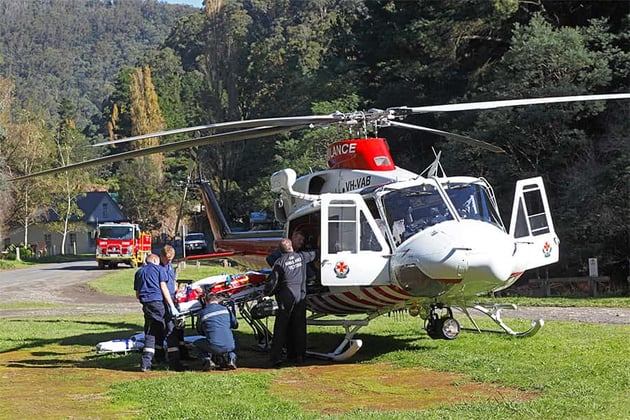
Which, the other maybe less tangible element to this is that moving patients out is very disruptive to the patient. It's not ideal for medical care, and it's certainly not ideal for family and loved ones when the patient suddenly disappears from their region.
So we find that the cost of Pulsara is not an issue for us; that all the other elements in the costings more than cover what the initial outlay would be.
And the other thing that's important, as with any bit of technology that you buy, the serious bang for the buck comes in the background support. I can buy a really cool technology, but if I've got zero background support, then I'm really thinking, do I want to buy this? Because if something happens and I haven't got anyone I can turn to, I'm on my own here. And I have to say that, again, without wanting to appear as a Pulsara salesman—and as Kris highlighted I'm getting no money for this—but we've had a fantastic working relationship with Pulsara and their support has been excellent. So I think the cost is not an issue. And I'm going to really go out on a limb here and put myself in hot water, but I have to say for what we get, I think it's cheap at the price. So all Pulsara people can please block their ears for that one. Yeah, it's fantastic.
Kris Kaull:
Yeah, I think you spoke to it. When you put it in context and speak to the cost holistically, man, there's a lot more to it.
For our audience and blog readers: if you have any questions about Pulsara and are interested particularly in the Australia area, we welcome you to get in touch with Michael Drummond, our Regional Director for the APAC region. For general questions or interest in other areas of the world, contact us directly at Pulsara. We would love for you to get a hold of us.
Bottom line, there's a ton of great information here. We hope you can take these best practices and words of wisdom and apply them in your community. To our panelists today, you are amazing. Thank you so much. By paying forward the great work you've all done, you will be an inspiration for others in Australia and across the globe.
![]()
If you missed Part 1 and Part 2 of our roundtable discussion with the team in Victoria, you can find the rest of their story here.
If you're interested in learning more about how Pulsara can help your organization reduce treatment times, cut costs, improve relationships between your care teams, and overall improve your communication process, learn more at Pulsara.com.

Editor's Note: In July 2025, EMS1 and Fitch & Associates released their annual EMS trend survey, What Paramedics Want, proudly sponsored by Pulsara....
![[PRESS RELEASE] Published Research Finds Up to 31% Faster STEMI Treatment Times in Rural Hospital Setting with Pulsara](https://www.pulsara.com/hubfs/_1_website-page-blog-assets/pulsara-hosp-teams-assign-cardio-stemi-rn-1200x701.jpg)
Published research shows how using Pulsara, alongside standardized field activation and a focus on stakeholder relationships, improves STEMI care and...
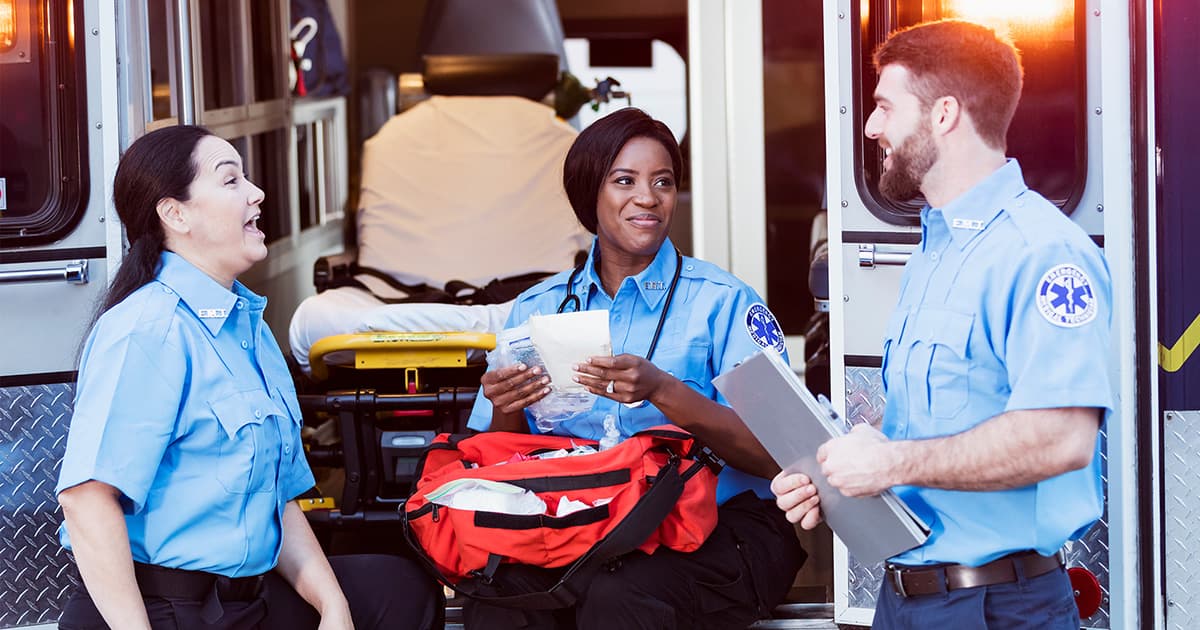
Editor's Note: In July 2025, EMS1 and Fitch & Associates released their annual EMS trend survey, What Paramedics Want, proudly sponsored by Pulsara....